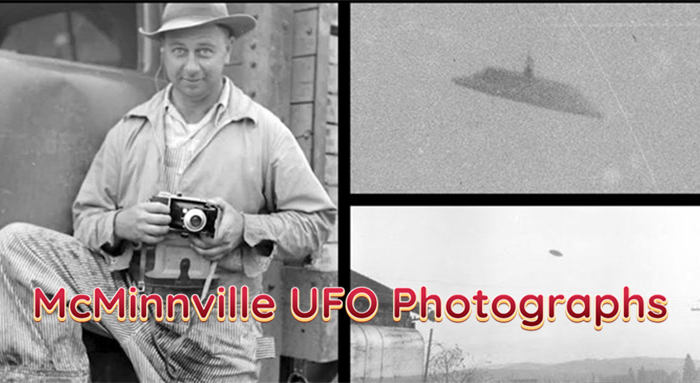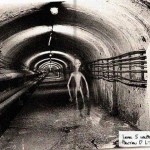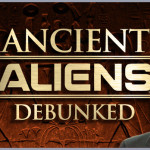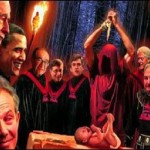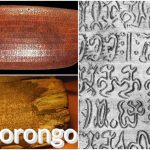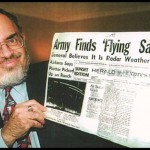The 1950 McMinnville UFO photographs event is a mysterious incident filled with enigma. At that time, a woman named Pauline Trent witnessed a metallic disc-shaped object flying from the northeast sky over a tranquil farm in Oregon. This extraordinary sight not only shocked her but also changed her life forever. This event became a captivating UFO mystery that drew widespread attention globally. In this story, we will unveil the veil of this mysterious event and learn more about the secrets behind these intriguing photographs and the event itself.
Two Unusual Photographs
After the famous Kenneth Arnold sighting event in June 1947 caused a public sensation, UFOs became a popular topic in the United States at the time, leading to numerous sighting reports, witnesses, and many unverified photographs. However, most of these so-called UFO photographs showed obvious signs of forgery and did not withstand close scrutiny and analysis. Just when people needed solid evidence, in 1950, a UFO flew over a farm in McMinnville, Oregon.
On May 11, 1950, Paul and Evelyn Trent witnessed a 100-foot flying saucer passing over their farm. Fortunately, they had a camera with them and captured two famous photographs from different angles, taken 30 seconds apart. On June 26, 1950, Life magazine published these two photos, which were considered the best UFO photographs ever taken at the time. They were not blurry images of lights in the sky, birds, or weather balloons; they depicted real, structured, and metallic objects. The only question left for people was whether they were genuine or a hoax. In the following years, the U.S. Air Force, the Central Intelligence Agency’s Condon Report, and other researchers separately studied these two photographs, which were featured in thousands of analysis articles. It’s worth noting that the Trent family never profited from these photos. At the time, there were two theories: these photos looked like the rearview mirror of a pickup truck suspended by wires or a garbage can lid thrown into the air. However, over time, the authenticity of these two photographs remained unproven, and people gradually accepted them as factual.
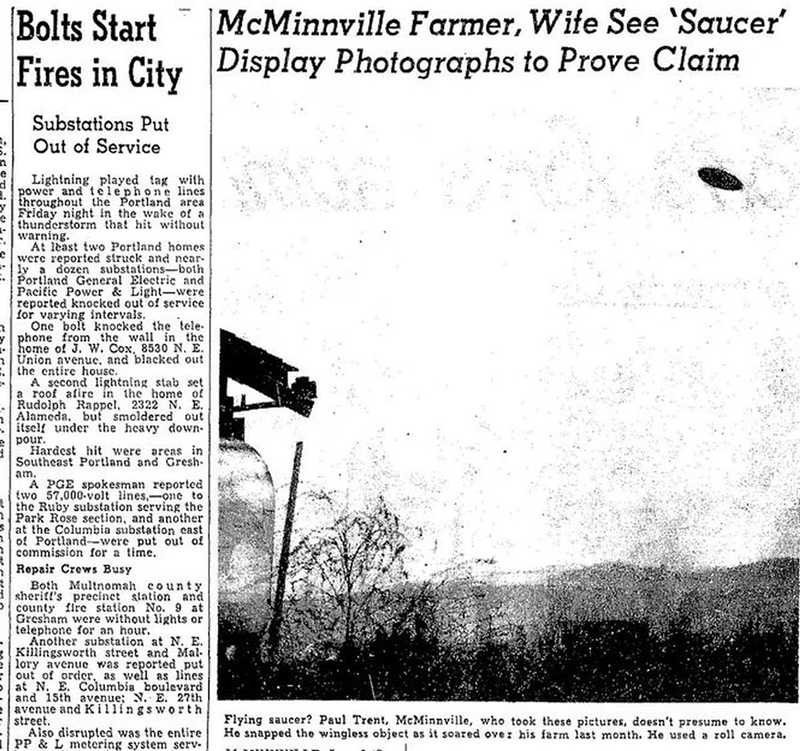
Flying Object Over the Farm
In the years immediately following the end of World War II, Paul and Evelyn Trent worked on a small farm in McMinnville, Oregon. This was a community focused on timber and agriculture, not far from the fertile Willamette Valley in Oregon. Life was tough, but they were hardworking people who stuck to a farmer’s schedule of early bedtimes and early rising. On the evening of May 11, 1950, around 7:30 PM, Evelyn was getting ready to tend to her evening chores, which included feeding the chickens and rabbits. Despite the overcast weather, the lighting was still good. As Evelyn was about to return to the house, she saw a two-toned disc-shaped aircraft silently gliding over the farm. She immediately knew it was something unlike anything she had seen before.
The top part was bronze-colored, and the bottom was silver. I’d say it was about the size of a large parachute, maybe even a bit larger. Evelyn hurried back to the house to call Paul to come and see. He also witnessed it and noticed that it emitted no sound and had no visible smoke or vapor around it. Paul owned a Roamer camera made by the Universal Camera Corporation. It used 60-millimeter film (equivalent to Kodak 120 or 620 film), and after each photo, it required several seconds to advance the film by rotating a small chrome knob. This camera was a significant investment for Paul and happened to be at the right place at the right time. Paul rushed into the house, grabbed the camera, and came out to capture the event.

As Paul returned outside with his camera, the object began to move. Paul acted quickly and took two famous photos within approximately thirty seconds. The first photo framed the object as it was flying away from the Trent farm, with their garage to the left, and a series of hills to the right and at the bottom. The second photo was crucial because Paul changed his shooting position, running a few yards to keep the object within sight, allowing for more detailed analysis later.
Front-Page Photos
What makes these two photos even more convincing is that the Trent family didn’t take any immediate action. They didn’t check the newspapers, nor did they develop the film right away. This was highly unusual, to the extent that when this story appeared in “Life” magazine a month and a half later, the article started with:
“Paul Trent, a farmer of McMinnville, Oregon, is a thrifty man. Last winter, he bought a roll of film and exposed it with a picture of the snow. A month later, he took a picture of a weeping willow in his front yard. On May 11 last, he saw a saucer fly over his house and exposed two pictures. He used up the last three exposures of the roll on Mother’s Day on the picnic of the family. Then he developed the film.”
This seems crazy by today’s standards when photos would be on the internet within seconds of taking them. Why did the Trents wait? Three reasons. Firstly, film was expensive, and there were a few frames left on the roll, which were precious to the budget-conscious Paul. Furthermore, in any case, the Trents were not seeking publicity. The third, and perhaps most unsettling reason, was that they feared they had seen some kind of government experiment, possibly a secret one. If they shared these photos with others, they might get into trouble.
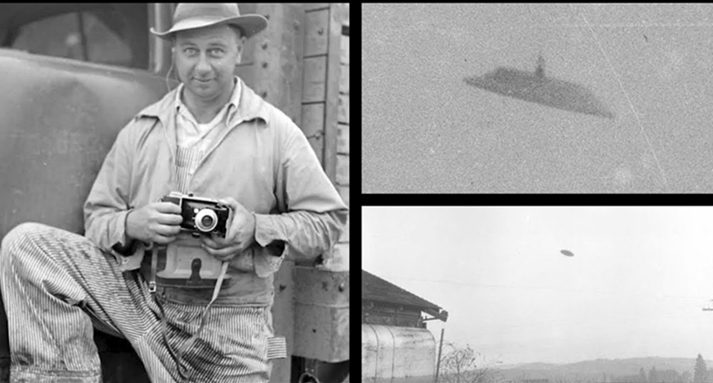
Of course, eventually, after developing the two photos, the Trent couple showed them to some friends and allowed them to be posted in their church. Frank Wortmann was deeply impressed and shared the Trent story with the “Telephone Register” in McMinnville. No one could dismiss these photos as just lights in the sky or weather balloons. They were clearly something else. If the Trents had planned the whole thing, they wouldn’t have waited so long to reveal the photos as they claimed. Considering their usual honest and upright reputation, it made the whole event more believable.
Over the next two days, newspapers in Portland, Oregon, and Los Angeles, California, published their own articles. Subsequently, this story gained global attention through the International News Service (INS) and the Associated Press (AP). How big of a deal was it? At the time, anyone could order a copy of the “Telephone Register” for just a nickel. The issue with the Trent photos was reprinted over 10,000 times within three weeks of its initial publication. This popular story set in motion what was inevitable to happen next. “Life” magazine, the largest-circulation magazine in the United States at the time, featured the photos in its June 26, 1950 issue. That issue quickly sold out.
Ultimately, the humble Trent couple participated in a television program recording in New York. However, they didn’t go on a nationwide tour, and after the recording, they returned to their farm. As the story continued to spread, some articles humorously referred to McMinnville as “Saucerville.” Though it was meant in jest, it brought the Trent family a kind of attention they weren’t too fond of. The FBI and the Air Force sent investigators to the Trents’ house, where they took their own photos, searched the house, and questioned the Trent family. If this were a hoax, all of this behavior would be rather odd. At the time, television personality and radio host Frank Edwards claimed to have enlarged these photos and delivered them to the Pentagon. He had to boast, saying, “Someone told me these are the best civilian photos of unidentified flying objects the Air Force has ever seen.” Despite the apparent enjoyment of their moment in the national spotlight, the Trent family didn’t profit from it, and they quickly grew weary of the attention. At the end of their lives, they expressed a wish that they had never taken those two photos.
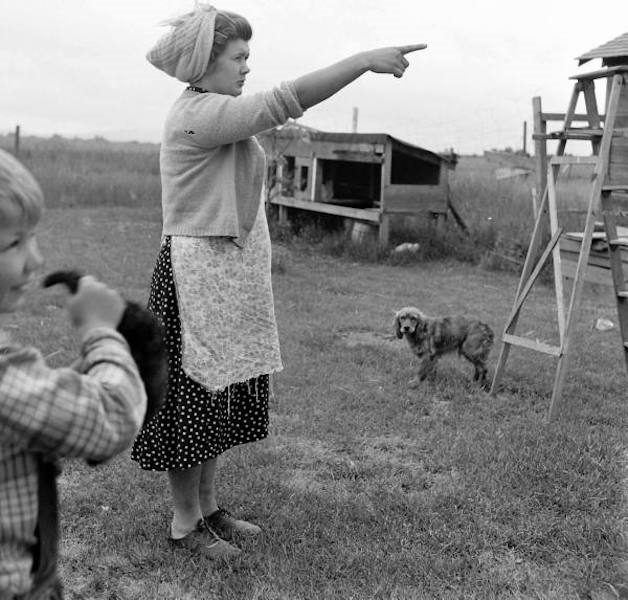
The Missing Negatives
After the Trents had the film developed at a local photo lab, they had to wait for a whole week. Photography technology back then wasn’t as advanced as it is today. When they finally received the developed photos, they didn’t immediately show them to someone who could appreciate them. In fact, the next person to see the photos was Bill Powell, a reporter for the McMinnville newspaper, who, in his own words, “attacked these photos in every way,” though he could never figure out how they could have been faked.
When the Trents went to New York to record a program, the show’s producers had them bring the negatives to New York. According to the Trents, the program “borrowed” the negatives. However, the Trents never saw those negatives again. When they inquired, they were told they had “misplaced” them. Subsequently, the negatives of these two photos ended up in the UPI news office.
Another version of the story regarding the negatives comes from UFO historian Richard Dolan. Dolan says that after local news reports, the Trent family was visited by both the FBI and the Air Force. They also interviewed reporter Powell because he likely had the negatives. An Air Force agent demanded the negatives but never returned them. Powell reportedly made multiple requests to have them returned, but he never received a response. These two stories are completely different. One involves the negatives being handed over to a national television program and then passed to UPI, while the other involves Powell handing them over to government officials. This sounds contradictory, especially considering what happened next. However, it can be confirmed that the negatives were lost in 1950.
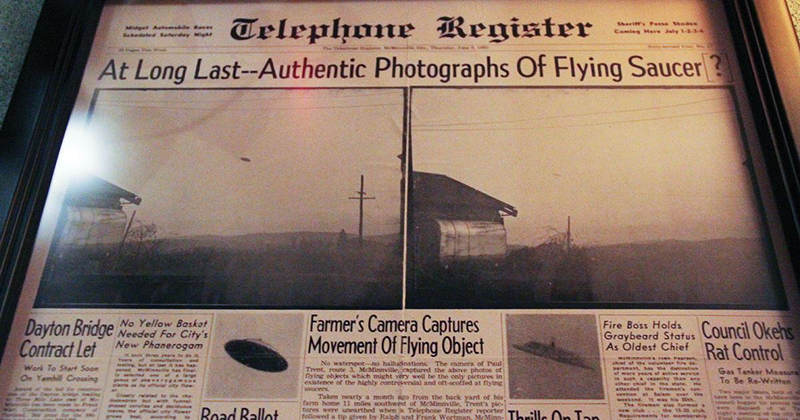
Condon Committee Investigation
It wasn’t until the late 1960s that this story had a new development. At that time, the U.S. Air Force, in collaboration with the University of Colorado, commissioned an investigation into UFO phenomena and established the “Condon Committee.” During the investigation, the Trent negatives miraculously reappeared in the UPI archives after being missing for seventeen years. They were subsequently handed over to the Condon Committee for analysis.
Astronomer William K. Hartmann was responsible for the photo evidence section of the Condon Committee’s analysis, and he established a photo screening mechanism, listing basic requirements for UFO photos: no mistaken identity, no clear signs of fakery, and image quality clear enough for good analysis.
Ultimately, only two cases passed this screening, and the Trent case was one of them. After years of thorough scientific investigation, the Condon Report, in 1968, stated regarding these photos:
“This is one of the few UFO reports in which all factors investigated, geometric, psychological, and physical, appear to be consistent with the assertion that an extraordinary flying object, silvery, metallic, disc-shaped, tens of meters in diameter, and evidently artificial, flew within sight of two witnesses.”
Hartmann calculated through photometry that, in the first photo, the object was just over one kilometer away from the camera. He also concluded that its diameter was approximately 30 meters or 100 feet.
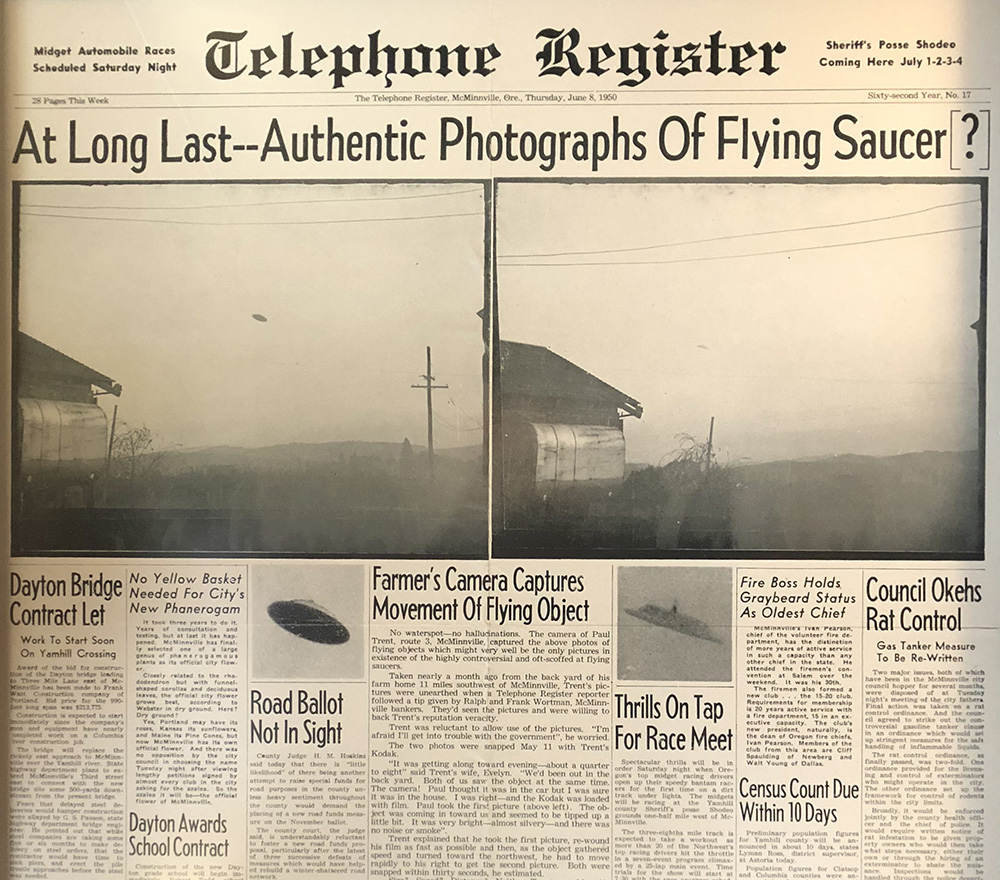
The conclusions of the Condon Report not only reaffirmed the Trent case’s status at the forefront of UFO legend but also triggered a series of theories attempting to discredit these photos, which, in turn, led to further investigations into the case.
After the conclusion of the Condon Committee’s investigation, documents show that the negatives were returned to UPI and then to the McMinnville “News Register” (formerly “Telephone Register”) in 1970. When they appeared in the newspaper again, it had been twenty years since the Trents originally took the photos. However, this time, the negatives had been significantly altered. Someone had cropped them, trimmed the edges, and reduced their overall size, to the extent that some portions of the original images were lost.
Why would someone crop the negatives? There are only two good reasons. The first is for image clarity. The nearby telephone wires were cropped out compared to the pictures published in “Life” magazine. This manipulation made the photos more dramatic, which leads to the second reason: people wouldn’t see the telephone wires, and they wouldn’t think these photos were of hubcaps or gas caps suspended by wires or strings.
Other Voices
As analyzed by Hartmann, while the Condon Report generally took a positive view of the authenticity of UFOs, it seemed to strongly support the authenticity of the photos. This continued for about six years. It was during that time that skeptics like Robert Sheaffer and the late Philip Klass decided to weigh in. They could never ignore the clarity of the photos and what they implied if genuine, so they focused on the hoax aspect. They even had a favorite suspect, the side-view mirror of a pickup truck driven by Paul, hanging on one of the telephone lines. In 1974, they concluded that the verbal accounts and photographic evidence did not align. Specifically, they believed the photos were taken in the morning rather than the claimed evening.
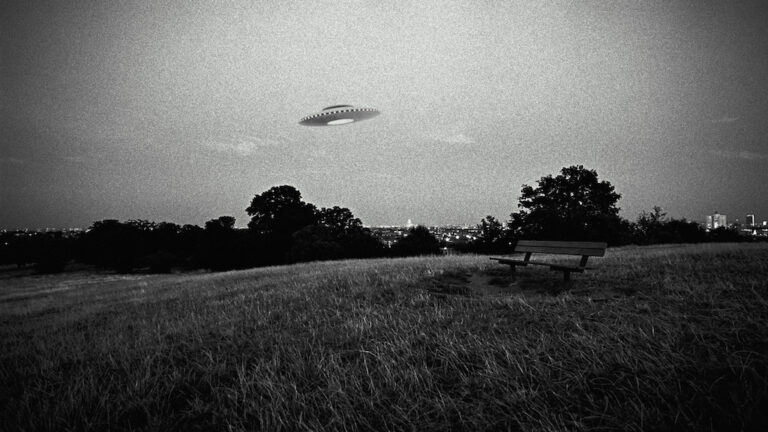
Between 1975 and 1976, optical physicist Dr. Bruce Maccabee borrowed the negatives from the Trent family. Maccabee worked in optical data processing at the U.S. Navy Surface Warfare Center, making him somewhat of an expert. He put these photos through every test he knew and attempted to find possible fraud. At the same time, he interviewed people and personally conducted experiments to determine what a fake photo of a UFO hanging from a string would look like. Ultimately, Maccabee wrote a lengthy report and concluded that these two photos were not hoaxes but real. He stated in the report:
“The Trent photos are classic because of their ‘antiquity,’ their object is depicted so sharply as to suggest either a model (hoax) or an ‘extraordinary flying object.’ The case also nicely illustrates the fact that mere sharpness of the photo and a few witnesses are insufficient when trying to prove an unusual sighting to be real. From the time the photos were published, no one who had not talked with the Trents before they got much publicity has offered an explanation. These explanations are often based on incomplete or imperfect investigations of the case. Unfortunately, the scientists had no interest in the case when the photos were first published, and the opportunity to talk to the Trents or to analyze the negatives was lost forever.” Maccabee concluded that the photos showed a “real, physical” object in the sky above the Trent farm. He believed the Trents’ story and their photographic evidence.
Postscript
To this day, these photos have taken on a life of their own, regarded by many as some of the most significant images in UFO history, making the McMinnville incident one of the most reliable UFO sighting cases in history. Undoubtedly, with the advancement of technology, there will be new opportunities to reexamine these photos, and new questions may arise at that time. However, their authenticity remains the prevailing opinion among most people. It’s worth mentioning that there is also another piece of evidence supporting the photos’ authenticity. On March 5, 1954, a French military pilot near Rouen, France, captured a photo of a UFO, almost four years later than the Trent photos. It matches the configuration of the “picket fence” type photos completely.
Over the years, the Trent family has continued to be interviewed about these photos. Details about the exact circumstances of taking the photos have shifted over time, as with any fading memory. Still, the overall story they’ve told has remained consistent and has maintained its credibility over the years. The Trents never attempted to profit from these photos, nor did they claim rights to these photos. In 1998, Paul commented on this:
“I took pictures, but I don’t want them. The first thing I knew is we’d get too much publicity.”
Evelyn agreed with her husband’s sentiment:
Like I say, I’ll never take another picture again. Too much publicity.
END:
The McMinnville UFO photographs event, with its uniqueness and relative honesty, has continued to inspire the exploration of unidentified flying objects. While the authenticity of the photographs has remained a subject of debate over the years, they provide a significant case study for UFO research, emphasizing the importance of investigation and analysis. The interpretations and counterarguments stemming from this case have prompted scientists and skeptics to think further about UFO phenomena.
These photographs have also become a crucial milestone in the history of UFO studies, demonstrating that both enthusiasm and the scientific method can work together to advance our understanding of the unknown. With ongoing technological advancements, the future will offer more tools and opportunities for scientists to delve deeper into these photographs to determine whether they represent something previously unknown in our world.
The impact of the McMinnville UFO photographs event on UFO research will remain timeless, reminding us to keep open minds and to continually seek the truth, no matter what challenges those truths may pose. These photographs present us with a perpetual question: whether we exist alone in the universe or coexist with other forms of life. Regardless of the answer, the McMinnville UFO photographs event provides us with an ongoing opportunity to explore the cosmos and urges us to remain humble and committed to the pursuit of truth in the face of the unknown.
More UFOs and mysterious files, please check out our YouTube channel: MysFiles
The Day After Roswell – UFO secrets and Reverse Engineering
